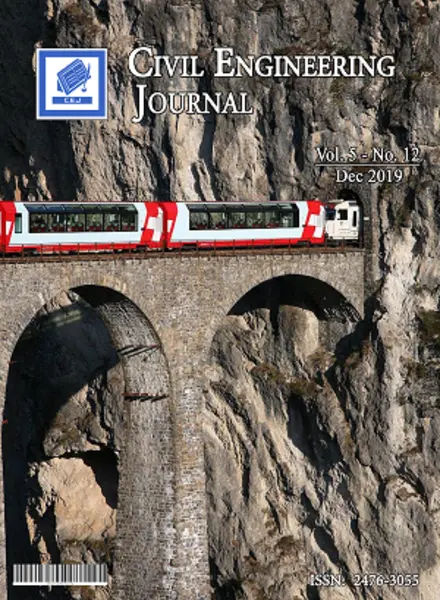-
mineralogy, micro-fabric and the behavior of the completely decomposed granite soils
جزئیات بیشتر مقاله- تاریخ ارائه: 1400/08/01
- تاریخ انتشار در تی پی بین: 1400/08/01
- تعداد بازدید: 482
- تعداد پرسش و پاسخ ها: 0
- شماره تماس ژورنال: 982188779475ext.258
mineralogy, micro-fabric and the behavior of the completely decomposed granite soils
the main objective of this study is to investigate the impact of the micro-fabric and soil mineralogy on the overall macro-behavior of the completely decomposed granite soil through a set of drained and undrained triaxial shearing and isotropic compression tests on a medium-coarse grading completely decomposed granite soil. the mineral composition of the soil was a substantial factor governing the compressive behavior. the soil compressibility increased significantly in the case of existence crushable and weak minerals within the soil minerals like fragile feldspar, as well as the high content of fines, especially the plastic fines. the scanning electron microscopic photos indicated that the micro-fabric of the soil had a paramount impact on the compressive behavior. the mechanism of the volumetric change depended on the stress levels, the soil mineral composition and the grain morphology. in the low consolidated stress levels, the soils’ grains rearrangement was the prevailing mechanism of the volumetric change, particularly with the absence of weak and crushable minerals. on the other hand, at the high consolidated stress levels, particles’ crushing was the prevailing mechanism in the volumetric change. both the mechanisms of volume change could occur simultaneously at the low stress levels in the case of presence crushable minerals in addition to micro-cracks in the soil grains.
the soil showed an isotropic response after 250 kpa, as this stress level erased the induced anisotropy from the moist tamping preparation method. under the drained shearing conditions, the soil showed a contractive response, while during the undrained shearing conditions, the soil exhibited both the contractive and dilative responses with phase transformation points. the studied soil showed a unique critical state line, irrespective of the drainage conditions and initial states, the critical state line was parallel to the isotropic compression line in the void ratio−effective stress space. in the deviator−effective mean stresses space, the studied soil approached a unique csl with a critical stress ratio equal 1.5, corresponding to critical friction angle of 36.8°.
حوزه های تحت پوشش ژورنال
مقالات جدیدترین رویدادها
-
استفاده از تحلیل اهمیت-عملکرد در ارائه الگوی مدیریت خلاقیت سازمانی و ارائه راهکار جهت بهبود
-
بررسی تاثیر ارزش وجوه نقد مازاد بر ساختار سرمایه شرکت های پذیرفته شده در بورس اوراق بهادار تهران
-
بررسی تأثیر سطح افشای ریسک بر قرارداد بدهی شرکت های پذیرفته شده در بورس اوراق بهادار تهران
-
بررسی تأثیر رتبه بندی اعتباری مبتنی بر مدل امتیاز بازار نوظهور بر نقد شوندگی سهام با تأکید بر خصوصی سازی شرکت ها
-
تأثیر آمیخته بازاریابی پوشاک ایرانی بر تصویر ذهنی مشتری پوشاک ایرانی (هاکوپیان)
-
ارائه یک مدل برنامه ریزی ریاضی استوار برای طراحی و مکان یابی تسهیلات در زنجیره تامین حلقه-بسته
-
تاثیر بکارگیری سیستم مدیریت نگهداری تجهیزات پزشکی بر هزینه ها در بیمارستان ولیعصر (عج) اراک درسال 1385
-
حجاب از دیدگاه اسلام و مسیحیت
-
lemur: large european module for solar ultraviolet research
-
a method for calculating the joint coordinates of paraplegic subjects during the transfer movement despite the loss of reflective markers
مقالات جدیدترین ژورنال ها
-
مدیریت و بررسی افسردگی دانش آموزان دختر مقطع متوسطه دوم در دروان کرونا در شهرستان دزفول
-
مدیریت و بررسی خرد سیاسی در اندیشه ی فردوسی در ادب ایران
-
واکاوی و مدیریت توصیفی قلمدان(جاکلیدی)ضریح در موزه آستان قدس رضوی
-
بررسی تاثیر خلاقیت، دانش و انگیزه کارکنان بر پیشنهادات نوآورانه کارکنان ( مورد مطالعه: هتل های 3 و 4 ستاره استان کرمان)
-
بررسی تاثیر کیفیت سیستم های اطلاعاتی بر تصمیم گیری موفق در شرکتهای تولیدی استان اصفهان (مورد مطالعه: مدیران شرکتهای تولیدی استان اصفهان)
-
نگرشی تحلیلی به مرجع صالح برای رسیدگی به شکایات مطروحه نسبت به آرای صادره از سوی کمیسیون ماده 12 قانون زمین شهری
-
بررسی مفاهیم شخصیت و نظریه های مختلف مرتبط با آن
-
تشخیص بیماری دیابت بر مبنای سیستم های فازی و الگوریتم بهینه سازی وال
-
ارزیابی و تحلیل عملکرد شهرداری ایلام بر پایه رضایتمندی شهروندان
-
اثربخشی روایت درمانی گروهی بر کاهش علائم افسردگی و اضطراب در بیماران مبتلا به اختلال استرس پس از سانحه


سوال خود را در مورد این مقاله مطرح نمایید :